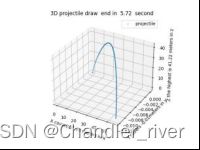Python数值分析案例01--------四阶龙格库塔法解抛体运动
在考虑到空气阻力(![]() )和因地球自转引起的科里奥利力后,列出运动方程
)和因地球自转引起的科里奥利力后,列出运动方程
![]() ---->抛出点的北纬读数
---->抛出点的北纬读数
![]() ---->表示地球自转角速度
---->表示地球自转角速度
算法:
四阶龙格库塔
代码
import numpy as np
import matplotlib.pyplot as plt
from mpl_toolkits.mplot3d import Axes3D
from math import *
def runge_kutta4(df,a,b,h,y0):
num = len(y0)
t = np.arange(a,b+h,h)
w = np.zeros((t.size,num))
w[0,:] = y0
for i in range(t.size - 1):
s0 = df(t[i], w[i,:])
s1 = df(t[i] + h/2.,w[i,:] + h * s0 / 2.)
s2 = df(t[i] + h/2.,w[i,:] + h * s1 / 2.)
s3 = df(t[i+1], w[i,:] + h * s2)
w[i+1,:] = w[i,:] + h * (s0 + 2*(s1+s2) + s3) / 6.
if w[i+1,:][2] <= 0:
q = i
xl,yl,zl = w[i+1,:][0],w[i+1,:][1],max(w[:,2])
break
return t,w,q,xl,yl,zl
def df(t, variables):
x,y,z,x1,y1,z1 = variables
A = np.zeros((3,3))
b = np.zeros(3)
A[0,0] = 1
A[0,1] = 0
A[0,2] = 0
A[1,0] = 0
A[1,1] = 1
A[1,2] = 0
A[2,0] = 0
A[2,1] = 0
A[2,2] = 1
phi = 30 * pi/180
k = 0.00001
n = 5
g = 9.8
b[0] = -2 * pi * 15/180/3600 * (cos(phi) * z1 - sin(phi) * y1) - k * (x1)**n
b[1] = -2 * pi * 15/180/3600 * sin(phi) * x1 - k * (y1)**n
b[2] = -g + pi * 15/180/3600 * 2 * cos(phi) * x1 - k * (z1)**n
x2,y2,z2 = np.linalg.solve(A, b)
return np.array([x1,y1,z1,x2,y2,z2])
a,b = 0.0,20.0
h = 0.01
x = 0
y = 0
z = 0
x1 = 10
y1 = 0
z1 = 70
y0 = np.array([x,y,z,x1,y1,z1])
t,w,q,xl,yl,zl = runge_kutta4(df, a, b, h, y0)
x = w[:,0]
y = w[:,1]
z = w[:,2]
x1 = w[:,3]
y1 = w[:,4]
z1 = w[:,5]
if 1:
fig = plt.figure()
ax = fig.add_subplot(projection='3d')
ax.scatter(x,y,z,label="projectile",s=0.5)
ax.set_xlabel("X"+" covers "+str(round(xl,2)) +" meters in x")
ax.set_ylabel("Y"+" covers "+str(round(yl,2)) +"meters in y")
ax.set_zlabel("Z"+" the highest is "+str(round(zl,2)) +" meters in z")
ax.set_title("3D projectile draw"+" end in "+str(q*h)+" second")
ax.legend()
else:
#plt.plot(x,z)
plt.plot(x,y)
plt.show()
效果图

